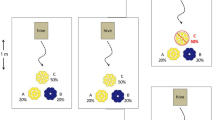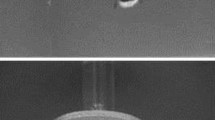Abstract
Individual bees often prefer flowers of the same species that they are already foraging on, and other individual bees prefer other flowers. This “floral constancy” has classically been explained as a learned behavior by which bees avoid wasting time switching between handling techniques. Choice trails were given to Bombus vagans workers that were freely foraging in mixed and pure fields of Trifolium pratense, T. repens, Viccia cracca, and Prunella vulgaris. Contrary to expectation, (1) bees showed if anything a stronger preference for their flower type in pure fields where they lacked experience than in a mixed field where they had had the opportunity to learn, (2) there was greater constancy in a mixed field of the two morphologically similar Trifolium species than in a mixed field of the morphologically disparate T. pratense and P. vulgaris, and (3) bees were more willing to switch between flowers of distinct morphologies when the colors were similar than between flowers of distinct colors when the morphologies were similar. We suggest that constancy is due to some form of perceptual conditioning whereby individual bees become temporarily sensitized to one or a few floral cues.
Similar content being viewed by others
References
Bateman AJ (1951) The taxonomic discrimination of bees. Heredity 5: 271–278
Chittka L (1992) The colour hexagon: a chromaticity diagram based on photoreceptor excitations as a generalized representation of colour opponency. J Comp Physiol 170: 533–543
Chittka L, Shmida A, Trolje N, Menzel R (1994) Ultraviolet as a component of flower reflections, and the colour perception of Hymenoptera. Vision Res 34: 1489–1508
Darwin C (1859) The origin of species. Murray, London
Darwin C (1876) The effects of cross and self fertilisation in the vegetable kingdom. Murray, London
Free JB (1963) The flower constancy of honeybees. J Anim Ecol 32: 395–402
Frisch K von (1953) The dancing bees. Harcourt Brace, New York
Frisch K von (1967) The dance language and orientation of bees. Harvard University Press, Cambridge
Grant V (1949) Pollination systems as isolating mechanisms in angiosperms. Evolution 3: 82–97
Grant V (1950) The flower constancy of bees. Bot Rev 16: 379–398
Grant V (1994) Modes and origins of mechanical and ethological isolation in angiosperms. Proc Natl Acad Sci USA 91: 3–10
Heinrich B (1976) The foraging specializations of individual bumblebees. Ecol Monogr 46: 105–128
Heinrich B (1979) “Majoring” and “minoring” by foraging bumblebees, Bombus vagans: an experimental analysis. Ecology 60: 245–255
Laverty TM (1980) The flower visiting behaviour of bumble bees: floral complexity and learning. Can J Zool 58: 1324–1335
Laverty TM (1994) Costs to foraging bumble bees of switching plant species. Can J Zool 72: 43–47
Levin DA (1970) Reinforcement of reproductive isolation: plants versus animals. Am Nat 104: 571–581
Lewis AC (1986) Memory constraints and flower choice in Pieris rapae. Science 232: 863–865
Manning A (1956) Some aspects of the foraging behavior of bumblebees. Behavior 9: 164–201
Sokal RR, Rohlf FJ (1981) Biometry, 2nd edn. WH Freeman, New York
Straw R (1972) A Markov model for pollinator constancy and competition. Am Nat 106: 597–619
Thomson JD (1981) Field measures of flower constancy in bumblebees. Am Midl Nat 105: 377–380
Thomson JD, Maddison WP, Plowright RC (1982) Behavior of bumble bee pollinators of Aralia hispida Vent. (Araliaceae). Oecologia 54: 326–336
Waser NM (1986) Flower constancy: definition, cause, and measurement. Am Nat 127: 593–603
Wilson P, Thomson JD (1995) How do flowers diverge? In: Lloyd DG, Barrett SCH (eds) Floral biology. Chapman and Hall, New York
Zar JH (1984) Biostatistical analysis, 2nd edn. Prentice-Hall, Englewood Cliffs
Author information
Authors and Affiliations
Corresponding author
Rights and permissions
About this article
Cite this article
Wilson, P., Stine, M. Floral constancy in bumble bees: handling efficiency or perceptual conditioning?. Oecologia 106, 493–499 (1996). https://doi.org/10.1007/BF00329707
Received:
Accepted:
Issue Date:
DOI: https://doi.org/10.1007/BF00329707




